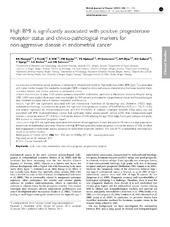| dc.contributor.author | Mauland, Karen Klepsland | en_US |
| dc.contributor.author | Trovik, Jone | en_US |
| dc.contributor.author | Wik, Elisabeth | en_US |
| dc.contributor.author | Ræder, Maria B. | en_US |
| dc.contributor.author | Njølstad, Tormund Salvesen | en_US |
| dc.contributor.author | Stefansson, Ingunn Marie | en_US |
| dc.contributor.author | Øyan, Anne Margrete | en_US |
| dc.contributor.author | Kalland, Karl-Henning | en_US |
| dc.contributor.author | Bjørge, Tone | en_US |
| dc.contributor.author | Akslen, Lars A. | en_US |
| dc.contributor.author | Salvesen, Helga Birgitte | en_US |
| dc.date.accessioned | 2017-08-03T12:44:02Z | |
| dc.date.available | 2017-08-03T12:44:02Z | |
| dc.date.issued | 2011 | |
| dc.identifier.issn | 0007-0920 | |
| dc.identifier.uri | https://hdl.handle.net/1956/16200 | |
| dc.description.abstract | Background: Endometrial cancer incidence is increasing in industrialised countries. High body mass index (BMI, kg m−2) is associated with higher risk for disease. We wanted to investigate if BMI is related to clinico-pathological characteristics, hormone receptor status in primary tumour, and disease outcome in endometrial cancer. Patients and methods: In total, 1129 women primarily treated for endometrial carcinoma at Haukeland University Hospital during 1981–2009 were studied. Body mass index was available for 949 patients and related to comprehensive clinical and histopathological data, hormone receptor status in tumour, treatment, and follow-up. Results: High BMI was significantly associated with low International Federation of Gynaecology and Obstetrics (FIGO) stage, endometrioid histology, low/intermediate grade, and high level of progesterone receptor (PR) mRNA by qPCR (n=150; P=0.02) and protein expression by immunohistochemistry (n=433; P=0.003). In contrast, oestrogen receptor (ERα) status was not associated with BMI. Overweight/obese women had significantly better disease-specific survival (DSS) than normal/underweight women in univariate analysis (P=0.035). In multivariate analysis of DSS adjusting for age, FIGO stage, histological subtype, and grade, BMI showed no independent prognostic impact. Conclusion: High BMI was significantly associated with markers of non-aggressive disease and positive PR status in a large population-based study of endometrial carcinoma. Women with high BMI had significantly better prognosis in univariate analysis of DSS, an effect that disappeared in multivariate analysis adjusting for established prognostic markers. The role of PR in endometrial carcinogenesis needs to be further studied. | en_US |
| dc.language.iso | eng | eng |
| dc.publisher | Nature Publishing Group | eng |
| dc.relation.ispartof | <a href="http://hdl.handle.net/1956/16202" target="blank"> Context-related biomarkers in endometrial cancer. A study with focus on obesity and genomic alterations</a> | |
| dc.rights | Attribution CC BY-NC-SA | eng |
| dc.rights.uri | http://creativecommons.org/licenses/by-nc-sa/3.0/ | eng |
| dc.subject | Body mass index | eng |
| dc.subject | endometrial carcinoma | eng |
| dc.subject | Prognosis | eng |
| dc.subject | progesterone receptor | eng |
| dc.title | High BMI is significantly associated with positive progesterone receptor status and clinico-pathological markers for non-aggressive disease in endometrial cancer | en_US |
| dc.type | Peer reviewed | |
| dc.type | Journal article | |
| dc.date.updated | 2017-08-03T12:31:20Z | |
| dc.description.version | publishedVersion | en_US |
| dc.rights.holder | Copyright 2011 Cancer Research UK | |
| dc.identifier.doi | https://doi.org/10.1038/bjc.2011.46 | |
| dc.identifier.cristin | 835640 | |
| dc.source.journal | British Journal of Cancer | |
| dc.source.40 | 104 | |
| dc.source.14 | 6 | |
| dc.source.pagenumber | 921-926 | |
| dc.subject.nsi | VDP::Medisinske Fag: 700::Klinisk medisinske fag: 750::Onkologi: 762 | en_US |

